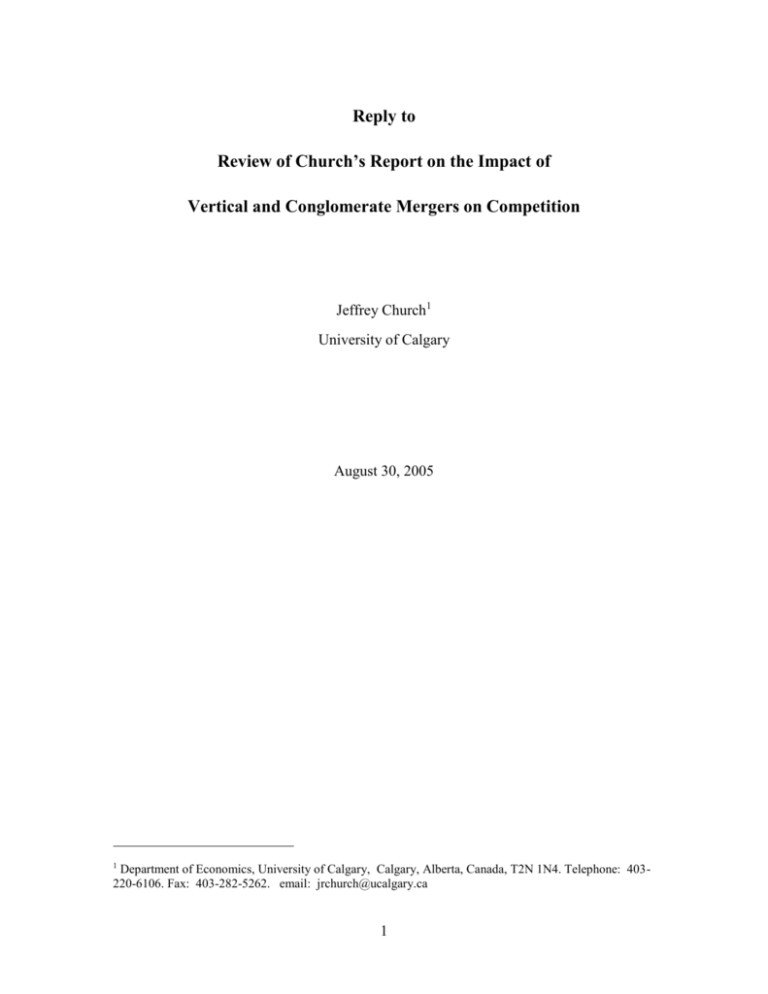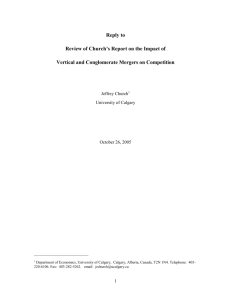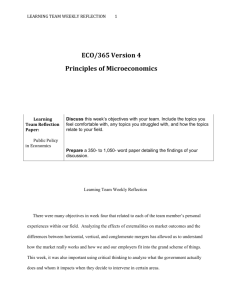Reply4
advertisement

Reply to Review of Church’s Report on the Impact of Vertical and Conglomerate Mergers on Competition Jeffrey Church1 University of Calgary August 30, 2005 1 Department of Economics, University of Calgary, Calgary, Alberta, Canada, T2N 1N4. Telephone: 403220-6106. Fax: 403-282-5262. email: jrchurch@ucalgary.ca 1 1.0 Introduction The report presents a framework for analysis of non-horizontal mergers after a careful review of the relevant economics literature. Just as with a horizontal merger, a non-horizontal merger only gives rise to antitrust concern if it creates market power, and just as with a horizontal merger, a non-horizontal transaction can enhance market power either because of a coordinated or unilateral effect. The literature surveyed on the anticompetitive rationales and effects of nonhorizontal mergers considered how the transaction changes incentives or constraints post-merger and thereby enhances the market power of the merged firm. For the unilateral effects of vertical mergers, the literature considered was of two sorts, settings that considered the potential for a transaction to result in input foreclosure and raise the costs of rivals downstream and settings where the concern is that a transaction might result in customer foreclosure, reducing the revenue of rivals upstream. The first is what is usually considered the economic literature on vertical mergers. The second, on customer foreclosure, is based on the economics of exclusive dealing or exclusionary contracts. The potential for a unilateral effect from a conglomerate merger was assessed by considering the economics of tying, bundling, and portfolio effects. The report also considered the possibility for a coordinated effect from a nonhorizontal merger, how and whether a conglomerate merger might affect incentives for financial predation and the implications for competition if such a merger affects financial leverage. It also briefly considers the efficiency rationales for non-horizontal mergers.2 In what follows I briefly comment on the review by Cooper, Froeb, O’Brien, and Vita (CFOV). The review of CFOV concentrates on my discussion of vertical mergers and the applicability of the proposed framework to vertical mergers. My remarks are organized around the following major points made by CFOV: (i) the policy implications of the “RRC literature on vertical merger does not support an aggressive stance against vertical mergers.”3; (ii) an increase in 2 A companion piece sponsored by DG Enterprise and Industry considers efficiency benefits associated with nonhorizontal mergers in detail. see S. Bishop et al. (2005), The Efficiency-Enhancing Effects of Non-Horizontal Mergers, Brussels: European Commission online at http://europa.eu.int/comm/enterprise/library/libcompetition/libr-competition.html. 3 CFOV at p. 4. market power is only a necessary, not sufficient condition for a non-horizontal merger to raise antitrust concerns; and (iii) their critique of the proposed structured rule of reason framework to evaluate non-horizontal mergers because of the treatment of efficiencies from the elimination of double marginalization or, in the case of a merger between complements, the Cournot effect. 2.0 The RRC Literature and Antitrust Policy towards Vertical Mergers The basic trade-off highlighted by the game-theoretic models (those involving oligopoly at least at one level of production and typically both pre and post merger) that determines the welfare effects of a vertical merger is as follows. On the one hand the merger eliminates double marginalization, reducing the costs of the merged firm, which ceteris paribus, encourages it to produce more downstream. On the other hand, if the effect of the merger is to raise the price of the upstream good, this raises the costs of the unintegrated downstream firms, reducing their output. The net effect on the downstream price depends on which of these two effects is stronger: raising rivals’ costs or elimination of double marginalization. My review of the literature suggests that the raising rivals’ cost effect will only dominate when a commitment by the merged firm not to supply competing downstream firms is credible. Credibility is typically created when the merged firm adopts a technology which makes its inputs incompatible, i.e., unusable, by its downstream rivals. In the literature there are only four theories which identify circumstances under which a vertical merger might result in a reduction in total welfare if foreclosure is credible. The circumstances identified by those four theories are discussed extensively. CFOV, for instance, report my discussion of the theory of Avenel and Barlet (2003) in which a vertical merger would result unambiguously in a reduction in consumer welfare, i.e. higher downstream prices.4 CFOV’s concern is that in their view 4 CFOV are correct in observing that the effect on total surplus might be positive from a vertical merger and foreclosure even if downstream prices rise because society is better off from the savings in fixed costs associated with the deterrence of an entrant upstream. However, my conclusion was not that “the welfare effects were unambiguous” (CFOV at footnote 6) but that it was unambiguous that downstream prices would rise. See Impact of Vertical and Conglomerate Mergers at p. 52. There is a substantial risk that some antitrust practitioners may rationalize aggressive enforcement policies towards vertical integration because it has been now shown that circumstances exist in which vertical mergers can be anticompetitive. This regrettable (and doubtless unintended) outcome could have been avoided had the monograph included a short paragraph in which the policy implications of this literature were addressed more explicitly. CFOV are correct in that such an inference is clearly unintended and that such an inference is not warranted. The discussion of the theoretical literature must be understood in the context of the proposed antitrust framework. That framework is a structured rule of reason that involves three stages: “(i) a market power screen; (ii) identifying a coherent theory of anticompetitive harm (profit maximizing behaviour in theory) and its factual relevance (profit maximizing behaviour in practice); and (iii) assessment of the nature and magnitude of efficiencies.”5 The focus of the literature review is on identifying “theories of anticompetitive harm associated with nonhorizontal mergers (stage two) and the factual circumstances when they are applicable.”6 The second stage involves an assessment of whether the facts of a particular case are consistent with a theory of competitive harm. The theories identified are applicable only when the indicated factual circumstances are present.7 3.0 Market Power is Necessary, Not Sufficient 5 Impact of Vertical and Conglomerate Mergers at p. iv. 6 Impact of Vertical and Conglomerate Mergers at p. 10. 7 For instance, one concern of CFOV is the sensitivity of the results to linear or uniform pricing. CFOV argue that if there is nonlinear pricing there is unlikely to be an anticompetitive effect (at p. 4). If nonlinear pricing is prevalent, then, as indicated by CFOV, input foreclosure is not relevant, since it depends on a increase in the per unit price paid by downstream firms post merger. However, it is still possible that there could be customer foreclosure. Section 3.3 of the study considers customer foreclosure. Customer foreclosure occurs when the vertically integrated firm created by the merger no longer sources supply from upstream competitors, but continues to supply its downstream competitors. A strategy of customer foreclosure, or reducing rivals’ revenue, is designed to create market power upstream. It can do so under very specific circumstances if the loss of volume from foreclosure reduces the scale of upstream rivals so that they are induced to exit even if nonlinear, i.e., efficient contracting is practiced. See Impact of Vertical and Conglomerate Merger at pp. 114-115 for the complete list of factual circumstances which must be present for the Bernheim and Whinston (1998) model of exclusive dealing to indicate anticompetitive harm from, and incentive to, vertically merge and foreclose. The Bernheim and Whinston analysis, unlike O’Brien and Shaffer (1997), shows that the introduction of noncoincident market effects can result in an incentive for foreclosure which is profitable, and harms consumers. A noncoincident market means that the market power created upstream is exercised in a different downstream market than the vertically integrated firm participates in. CFOV “wish that Professor Church had emphasized that ‘an increase in market power’ is a necessary, but not sufficient, condition for a non-horizontal merger to raise antitrust concerns.”8 Their concern is that enforcement might be based on a finding that an increase in market power is all that is required and that since an increase in market power does not necessarily result in harm to consumers, enforcement will be welfare reducing. CFOV present a simple example in which post merger a firm acquires a demand advantage from one stop shopping is able to exercise more market power even though consumer welfare will not be negatively impacted.9 I am in agreement on the basic point made by CFOV. For conduct—in this case a nonhorizontal merger—to raise antitrust concerns, it must, as indicated in the passage quoted by CFOV, increase market power. However, as also indicated repeatedly in both the discussion of the structured rule of reason and in the discussion of each theory itself, antitrust enforcement is only warranted when market power is enhanced and there is anticompetitive harm defined as either a decrease in total surplus or consumer surplus.10 Hence I would agree that in the circumstances of their example, enforcement action is not warranted even though the market power of the multiproduct firm is enhanced by the merger unless it resulted in the exit of rivals and a sufficient increase in market power to overcome the increased benefit to consumers.11,12 4.0 The Role of Efficiencies and the Appropriate Framework for Analyzing Non-Horizontal Mergers 8 CFOV at p. 5. 9 CFOV at p. 6. 10 See Impact of Vertical and Conglomerate Merger at pages iii, iv, and 9. 11 This assumes a consumer welfare standard. A total welfare or surplus standard would be more lenient since it would count any fixed cost savings as a gain along with the increased benefit from one-stop shopping. 12 I would not consider this merger vertical. Instead it strikes me that it is better to consider (and analyze) it has a conglomerate merger. In this respect the savings to consumers from one stop shopping increase their demand for the conglomerates products and reduce demand for its single product competitors. Depending on the extent to which demand is reduced and the extent of fixed costs, the effect of one stop shopping may be to induce exist of the single product rivals. However, even if the demand shift is significant enough to result in monopolization, consumers might still be better off. The primary objective of the report was to identify “theories of anticompetitive harm associated with non-horizontal mergers (stage two) and the factual circumstances when they are applicable.”13 Anticompetitive harm is identified, depending on the relevant standard, if either consumer or total surplus declines as a result of the transaction. In all four legitimate case theories identified for a vertical merger to result in input foreclosure the set of circumstances identified as indicating anticompetitive harm arise when the benefits of eliminating double marginalization are insufficient to overcome the effects of the increase in market power.14 Thus as CFOV observe stage (ii)—identifying a coherent and relevant theory of harm—does include a netting out of these two effects. The burden of proof on the plaintiff should be on demonstrating not that the non-horizontal merger enhances market power, but, (typically on the balance of probabilities) results in an anticompetitive effect (either a reduction in consumer or total surplus). Stage (iii) puts the burden on the defendant to identify non pricing externalities that overcome any anticompetitive harm. These efficiencies, as discussed briefly in Section 7 of the report could arise from (i) production efficiencies and savings; (ii) internalization of vertical externalities and alignment of incentives; and (iii) transaction cost savings, including mitigating opportunistic behaviour. Finally, CFOV agree on the necessity of a coherent and relevant theory of anticompetitive harm. They are concerned about the ability to apply the theories identified in the report in practice. My response to this is simple: the onus is on the plaintiff to make the case. This involves identifying a theory of anticompetitive harm that is coherent, i.e. profit-maximizing and that is relevant, i.e., matches the facts of the case. The key to requiring a specific theory of harm and showing its relevance, rather than a presumption of anticompetitive harm, based on market share or extent of the market foreclosed, will not be easy, consistent with the emphasis by CFOV on the efficiencies associated with vertical mergers, and to a lesser extent, conglomerate mergers. Also consistent with the prevalence and importance of efficiencies in considering the welfare impacts of vertical mergers, a relatively tight match between facts and theory should be required. 13 Impact of Vertical and Conglomerate Mergers at p. 10. 14 A similar observation applies to the Cournot effect and conglomerate mergers. 5.0 Conclusion The scope and detail of the study were more, if not substantially more, than originally envisioned by DG IV or I. In this regard the positive review by CFOV is much appreciated. Their comments suggest, however, continued tension in the antitrust community on the appropriate objective of antitrust policy and the role of theory in crafting welfare enhancing enforcement policy.








